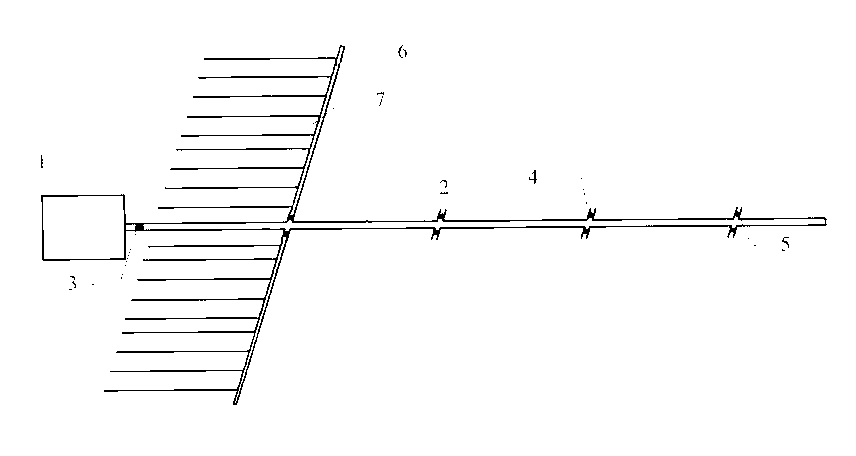Method for recovering vegetation in desertified land in extremely droughty area
A technology for vegetation restoration and arid areas, applied in the field of ecological construction, can solve the problems of surface vegetation destruction, high investment costs, and difficulty in germination and growth on the surface, and achieve the effect of promoting ecological restoration, low investment, and high utilization rate
- Summary
- Abstract
- Description
- Claims
- Application Information
AI Technical Summary
Problems solved by technology
Method used
Image
Examples
Embodiment 1
[0020] a. Establish irrigation water source 1, install irrigation power, lay out mobile irrigation pipe network, install main valve 3 at one end of main pipe 2, and install branch pipe connection ports 4 and branch pipe connection ports 4 in equal arrangement on main pipe 2 A valve 5 is installed to connect the branch pipe 6 to the branch pipe connection port 4, and only a pair of branch pipes 6 are connected to the main pipe 2, and the branch pipe 6 is connected to each branch pipe connection port 4 on the main pipe 2 by moving the branch pipe 2 to realize irrigation for different sections;
[0021] b. Connect the drip irrigation capillary 7 with the branch pipe 6. The distance between the capillary 7 is 2m, and the distance between the drippers is 1m. If the soil seed bank in desertified land has very low reserves or there are no plant seeds with deep roots, it must be dug shallow under the capillary 7 before irrigation. Ditch, sow local deep-rooted plant seeds, and then bury...
Embodiment 2
[0027] a. Establish irrigation water source 1, install irrigation power, lay out mobile irrigation pipe network, install main valve 3 at one end of main pipe 2, and install branch pipe connection ports 4 and branch pipe connection ports 4 in equal arrangement on main pipe 2 A valve 5 is installed to connect the branch pipe 6 to the branch pipe connection port 4, and only a pair of branch pipes 6 are connected to the main pipe 2, and the branch pipe 6 is connected to each branch pipe connection port 4 on the main pipe 2 by moving the branch pipe 2 to realize irrigation for different sections;
[0028] b. Connect the drip irrigation capillary 7 with the branch pipe 6. The distance between the capillary 7 is 3m, and the distance between the drippers is 2m. If the soil seed bank in desertified land has very low reserves or there are no plant seeds with deep roots, it is necessary to dig shallow under the capillary 7 before irrigation. Ditch, sow local deep-rooted plant seeds, and t...
Embodiment 3
[0034] a. Establish irrigation water source 1, install irrigation power, lay out mobile irrigation pipe network, install main valve 3 at one end of main pipe 2, and install branch pipe connection ports 4 and branch pipe connection ports 4 in equal arrangement on main pipe 2 A valve 5 is installed to connect the branch pipe 6 to the branch pipe connection port 4, and only a pair of branch pipes 6 are connected to the main pipe 2, and the branch pipe 6 is connected to each branch pipe connection port 4 on the main pipe 2 by moving the branch pipe 2 to realize irrigation for different sections;
[0035] b. Connect the drip irrigation capillary 7 with the branch pipe 6. The distance between the capillary 7 is 4m, and the distance between the drippers is 3m. If the soil seed bank in desertified land has very low reserves or there are no plant seeds with deep roots, it must be dug shallow under the capillary 7 before irrigation. Ditch, sow local deep-rooted plant seeds, and then bury...
PUM
 Login to View More
Login to View More Abstract
Description
Claims
Application Information
 Login to View More
Login to View More - R&D Engineer
- R&D Manager
- IP Professional
- Industry Leading Data Capabilities
- Powerful AI technology
- Patent DNA Extraction
Browse by: Latest US Patents, China's latest patents, Technical Efficacy Thesaurus, Application Domain, Technology Topic, Popular Technical Reports.
© 2024 PatSnap. All rights reserved.Legal|Privacy policy|Modern Slavery Act Transparency Statement|Sitemap|About US| Contact US: help@patsnap.com








